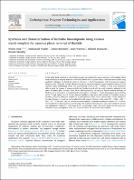| dc.contributor.author | Ojok, Walter | |
| dc.contributor.author | Ntambi, Emmanuel | |
| dc.contributor.author | Bolender, James | |
| dc.contributor.author | Wasswa, John | |
| dc.contributor.author | Wanasolo, William | |
| dc.contributor.author | Moodley, Brenda | |
| dc.date.accessioned | 2022-08-28T10:48:32Z | |
| dc.date.available | 2022-08-28T10:48:32Z | |
| dc.date.issued | 2022-08-24 | |
| dc.identifier.citation | Ojok, W., Ntambi, E., Bolender, J., Wasswa, J., Wanasolo, W., & Moodley, B. (2022). Synthesis and characterization of hematite biocomposite using cassava starch template for aqueous phase removal of fluoride. Carbohydrate Polymer Technologies and Applications, 100241. | en_US |
| dc.identifier.issn | 2666-8939 | |
| dc.identifier.uri | http://dir.muni.ac.ug/xmlui/handle/20.500.12260/466 | |
| dc.description.abstract | In this study, facile synthesis of α-Fe2O3 biocomposite was mediated by cassava starch as a soft template. Batch mode evaluated its sorption behavior for fluoride removal from aqueous media. Characterization studies using analytical techniques confirmed the existence of porous α- Fe2O3 biocomposite with heterogeneous surfaces having a varied affinity for fluoride. The sorption process was optimized using central composite design (CCD) in response surface methodology (RSM) with a good model prediction (R2 = 0.9066). A study of the interaction effect showed the synergy of process variables on fluoride removal with the result's intensity indicated by the nature of contour plot curvature. Based on the RSM optimization, an optimum fluoride removal efficiency of 85.26 % can be achieved at an initial fluoride concentration of 55 mg/L, α- Fe2O3 biocomposite dose of 0.55 g, pH of 7.5, and contact time of 95 min. Sorption equilibrium data were well modeled by Freundlich isotherm (0.9916), indicating multilayer sorption on a heterogeneous surface of the sorbent with a varied affinity for fluoride. Presence of co-existing anions reduced fluoride removal efficiency in the order PO43− > HCO3− > SO42− > NO3− > CƖ− . At the same time, its kinetics was better modeled by pseudo-second-order kinetics (R2 = 0.9764), showing that the sorption process is rate-limiting. The sorption thermodynamics study showed that the process was spontaneous, exothermic, and entropy-driven physisorption. Hence, the results signify that the green synthesized α- Fe2O3 biocomposite could be a potential sorbent for sustainable defluoridation. | en_US |
| dc.language.iso | en | en_US |
| dc.publisher | Elsevier | en_US |
| dc.subject | Cassava starch | en_US |
| dc.subject | Hematite | en_US |
| dc.subject | Fluoride sorption | en_US |
| dc.subject | Kinetics | en_US |
| dc.subject | Equilibrium isotherm | en_US |
| dc.subject | Response surface methodology | en_US |
| dc.title | Synthesis and characterization of hematite biocomposite using cassava starch template for aqueous phase removal of fluoride | en_US |
| dc.type | Article | en_US |

